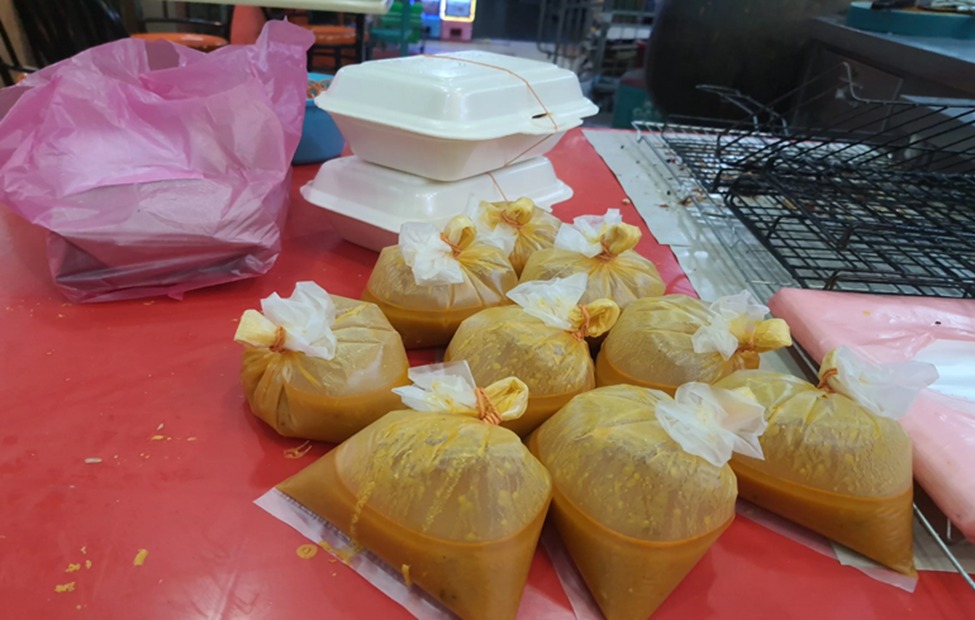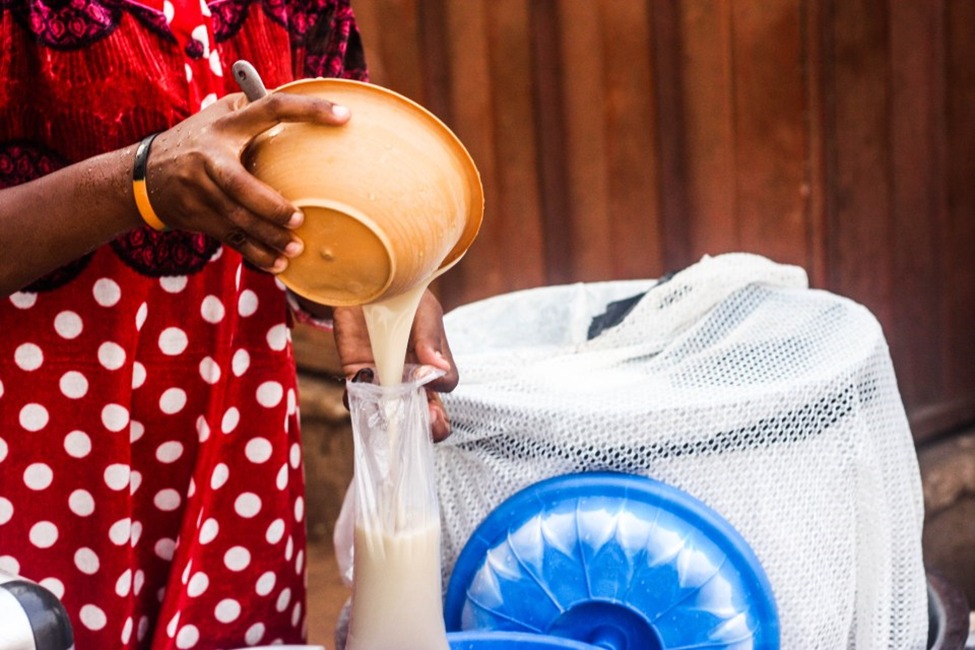I recently chanced on a video posted on Facebook by the renowned singer, Kofi Kinata lamenting how fante kenkey is now wrapped with plastic rubbers, then covered with the traditional plantain leaves before cooking on the fire.
His concern was that this predispose the consumers to several ailments. Indeed, this is a genuine concern. The fact is that Ga Kenkey is also suffering from this same fate. Additionally, most of our foods prepared at home such as banku are all wrapped in plastic sheets.
I had to educate my junior sister who studied catering in school not to wrap hot banku and foods in plastic rubbers. The dangerous thing is that the leftover banku is further boiled in hot water with these plastic rubbers.
The question I keep on asking is whether we are eating to live long or die. This is because the food we prepared, and how we store them are rather predisposing us to health conditions. I was sad when I visited my aunt at the hospital and found a nurse taking hot porridge in a plastic rubber. I asked myself; if a nurse or health worker is behaving like this, then, how would she educate the patient on healthy eating? The hard truth was that I saw many of the admitted patients eating their hot foods in rubbers.
Our life choices are killing us! we have become like the boiled frog story. Recently, a new study by Völker et al.(2022) linked plastics and obesity. This means that food containers and other everyday plastics could be contributing to bigger waistlines.

The new study looks at dozens of other potential plastic ingredients that cause obesity found in packaging and our homes. To gain a better understanding, researchers tested the chemicals found in 34 everyday products, including things like:
- Yogurt cups
- Soda bottles
- Refillable plastic water bottles
- Plastic cups
- Shampoo bottles
- Oven bags
- Vegetable trays
- And more
“Considering the chemical complexity of plastic consumer products, bisphenols, and phthalates represent only the tip of the iceberg,” researchers wrote.
Although your plastic packaging may have a number denoting the type of plastic (#5 or #2, for instance), the study authors point out that a plastic bottle typically is made out of one or more polymers and often contains fillers or additives, along with accidental residues from manufacturing.
But when scientists analyzed the 34 ordinary plastic products in the lab, they detected more than 55,000 different chemical components.
“Our experiments show that ordinary plastic products contain a mix of substances that can be a relevant and underestimated factor behind overweight and obesity,” says Martin Wagner, an associate professor at the Norwegian University of Science and Technology’s Department of Biology. Eleven of them are known to interfere with our metabolism, called metabolism-disrupting chemicals.
The new study found that one-third of plastic products tested contributed to fat cell development in laboratory experiments. Essentially, these compounds found in plastic reprogrammed cells to become fat cells that proliferated more and accumulated more fat.
“It’s very likely that it is not the usual suspects, such as bisphenol A, causing these metabolic disturbances. This means that other plastic chemicals than the ones we already know could be contributing to overweight and obesity.” – Johannes Völker, lead study author
This means that plastics contain currently unidentified chemicals that interfere with how our body stores fat.
The danger of eating food in plastics

Phthalates are chemical compounds that are commonly added to plastics to increase their flexibility, transparency, durability, and longevity. Phthalates are used in a wide range of cosmetic and food products — plus, they’re released into the environment. Diet is believed to be the main source of phthalates because fatty foods such as milk, butter, and meats are commonly packaged or stored in plastics containing this dangerous toxin. Hence, it is even deadly to eat or cook in plastic rubbers.
A 2018 study published in the scientific journal Environment International gives us even more reason to pay attention to this everyday threat. Researchers at George Washington University compared phthalate levels in people who ate home-cooked meals to those who frequently dined out at restaurants, cafeterias, and fast-food outlets. They found that on average, people who are eating food prepared outside of the home have nearly 35 percent higher levels of phthalates circulating in their bodies.
This means that there are a lot more hormone-disrupting chemicals running through their veins. And these chemicals are linked to a long list of health ills ranging from infertility and trouble losing weight to birth defects in kids and even certain cancers.
And while we’re on the subject of eating fast food on the go, you should know this: One-third of fast-food packaging also contains obesity-promoting, thyroid-damaging nonstick chemicals. It’s not just the calories we need to worry about anymore.
Phthalates are colorless, odorless liquids produced by reacting phthalic anhydride with an appropriate alcohol. And according to tests done by the Centers for Disease Control and Prevention, most Americans have metabolites of multiple phthalates in their urine.
While diet is believed to be our greatest exposure, these toxins can be absorbed through the air and skin too. Indoor concentrations seem to be significantly higher than outdoor concentrations, and indoor air pollution can be worse than outdoor. Plus, higher temperatures result in higher concentrations of phthalates in the air. A 2021 study found a link between phthalates and 100,000 premature deaths in America a year. Researchers estimate these early deaths result in up to $47 billion of lost wages in the U.S. annually.
Another study by Duty et al. (2003) suggests that environmental levels of phthalates are associated with altered DNA integrity in human sperm. The study consisted of 168 males who were recruited from the Massachusetts General Hospital Andrology Laboratory and provided semen and urine samples. The results indicate that monoethyl phthalate found in urine does increase DNA damage in sperm.
Another study by Hauser and Calafat( 2005) scientific review evaluated many animal and human studies associated with exposure to phthalates and reproductive development. In experimental animal studies, primarily in rodents, some phthalates induced reproductive tract developmental issues that consisted of epididymal malformations or absence of the epididymis, increased incidence of hypospadias (opening of the urethra in males), the decreased distance between the genitals and anus, delayed preputial separation (pubertal milestone), retention of thoracic nipples, and testicular lesions.
Some studies reported associations between pubertal and adult exposure to phthalates and testicular toxicity. There is also research to suggest that phthalates exposure prolongs the cycles of reproductive hormones, suppresses or delays ovulation, leads to smaller pre-ovulatory follicles due to reduced granulosa cell size, and decreases circulating serum oestradiol, which is a reproductive hormone.
Researchers agree that something had to be done about this dangerous chemical toxin. In 2010, the market was still dominated by high-phthalate plasticizers; however, due to current legal provisions and growing environmental awareness and perceptions, producers are increasingly forced to use non-phthalate plasticizers. It’s up to us, the consumers, to search out phthalate-free products and avoid using foods and goods that contain this serious toxin.
Can foods and baby feeding bottles are also not spared as they also contain BPA-Bisphenol A (known as BPA) a carbon-based, synthetic compound that is ubiquitous in modern-day life. It’s used in everything from shatter-resistant plastic water bottles and food storage containers to cash register receipts and canned food and drink liners.
A study by DeLuca et al.(2018), a first-of-its-kind, identified another risk factor a host of digestive health ailments, and this is huge. They identified BPA as a risk factor for inflammatory bowel disease.
Another big issue with BPA is the effect on infertility(Manfo et al. 2014) in a study from the University of Buea in Cameroon. Researchers uncovered some painfully shocking truths:
- It’s almost impossible to avoid BPA contact because, in addition to being in most packaged food items, it’s an environmental contaminant.
- BPA affects hormone balance and causes male reproductive dysfunction.
- BPA studies have shown that the most at-risk population is fetuses in-utero, a critical developmental stage for the embryo.
- BPA has been found to produce several defects in the embryo, such as the feminization of male fetuses, atrophy of the testes and epididymides, increased prostate size, shortening of AGD, disruption of BTB, and alteration of adult sperm parameters (for example, sperm count, motility and density).
- BPA affects the hypothalamic-pituitary-testicular axis by altering hormones in adults, which has been linked to sperm dysfunction.
- BPA induces oxidative stress in the testis and epididymis, which suggests antioxidant supplementation could help offset some of the BPA-induced side effects.
- BPA also prevents proper embryo thyroid development.
- Men occupationally exposed to BPA had high blood/urinary BPA levels, and abnormal semen parameters.
- Men exposed to BPA also displayed reduced libido and erectile ejaculatory difficulties.

A previous study by Yan et al.(2013) in China also found that “long-term exposure of female mammalians to BPA can lead to endocrine disorders in women, followed by the morphological and functional changes in ovary, uterus, vagina, and oviducts,” which have been linked to causing fertility issues. And these negative effects are seen in women who get pregnant naturally, as well as those who are trying to get pregnant via in-vitro fertilization (IVF).
Shelby(2008) study admitted it has some concerns over current human exposure levels to BPA. The main concerns involved impacts on the prostate gland in fetuses, infants, and children, along with brain and behavioral impacts at doses most people are exposed to every day.
Another study out of the University of California, San Francisco discovered that BPA exposure in female patients interfered with oocyte (the early stage of the female ovum before it is released). The health of the oocyte was diminished during IVF and could prevent proper implantation and conception.
Johns et al. (2016) breakthrough study found that exposure to BPA may lower levels of vitamin D in the bloodstream. Phthalates, another toxic hormone-disrupting chemical also seems to lower vitamin D levels in the body. There also was an association between exposure to higher levels of BPA and reduced vitamin D levels in women, although the relationship was not statistically significant in men.
Li et al. (2013) study evaluated the urine BPA levels in 1,326 school-aged children from Shanghai and linked BPA to obesity. They found that girls who had a higher urine BPA level were twice as likely to be obese than the average of the other children.
Another dangerous study done by Yan et al.(2011) found BPA changed the natural heartbeat signaling in female rates. This led to arrhythmia, an erratic beating that sometimes causes sudden cardiac death.
Sabanayagam et al.(2013) note that “higher urinary BPA levels are found to be associated with pre-diabetes independent of traditional diabetes risk factors.” This study is interesting because it clearly states, regardless of your diet and fitness levels, BPA has been shown to affect glucose metabolism through insulin resistance, pancreatic β-cell dysfunction, adipogenesis, inflammation, and oxidative stress.
Jedeon et al.(2013) study also found that daily BPA exposure damages tooth enamel. While this was a rat study, the findings suggest that the unhealthy changes dentists witness in 18 percent of children (white marks on teeth and brittle enamel) could be brought on by early contact with BPA.
Though some plastic manufacturers are opting for bisphenol S (BPS) and other chemicals, recent studies are proving that this new approach is just as bad (if not worse) than the original BPA.
Recent reports claim that more than 80 percent of Americans have detectable levels of BPS in their urine. According to lead author Professor Cheryl Watson:
“[Manufacturers] put ‘BPA-free’ on the label, which is true. The thing they neglected to tell you is that what they’ve substituted for BPA has not been tested for the same kinds of problems that BPA has been shown to cause. That’s a little bit sneaky.” Other studies reported the same results.
Take home

Since it is difficult to do away with these chemicals in our daily lives as they are even found in our plastic water bottles, sachet water, Baby foods, etc. The most dangerous of all is to eat hot foods in plastic rubbers. Boiling these foods wrap in rubbers on fire is a recipe for health disaster and you must do away with them. The following is recommended:
- Eat your waakye and others in plantain leaves;
- You can take personal action to eat fresh and avoid plastic food packaging, but overall better chemical safety regulations are needed to protect consumers;
- Avoid all foods wrapped and heated in plastic rubbers;
- Avoid heating or freezing food in plastic containers;
- Opt for food and drink containers made of glass or food-grade stainless steel;
- Consider an “obesogens detox” or “obesogens diet;
- Use microwave-friendly bowels; and
- Detox your system by drinking herbal teas daily
NB:
Prof. Nyarkotey has strict sourcing guidelines and relies on peer-reviewed studies, academic research institutions, and medical associations to justify his write-ups. My articles are for educational purposes and do not serve as Medical advice for Treatment. I aim to educate the public about evidence-based scientific Naturopathic Therapies.
The writer is a Professor of Naturopathic Healthcare, President, of Nyarkotey College of Holistic Medicine & Technology (NUCHMT)/African Naturopathic Foundation. E-mail: professor40naturopathy@gmail.com.





















